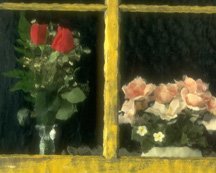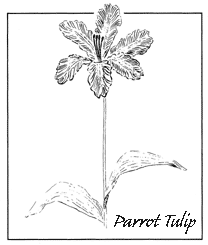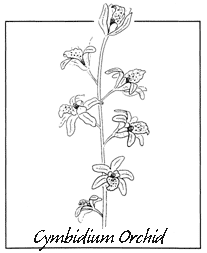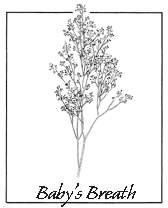Floral Design Basics:
A Guide to Floral Terminology
and the Elements of Design

Here's a free lesson in floral design basics. It's a quick guide to
floral terminology and the elements of design for making a fresh or silk
flower arrangement, along with a few tips on choosing an appropriate
design style.
Selecting Elements for
a Flower Arrangement
This
is a matter of personal preference, and it's half the fun! There are
principles of design, such as balance and proportion, that are important
guidelines to creating a pleasing flower arrangement. But as for
selecting the elements for a floral design, the combinations are
infinite and totally up to you.
I like to think there are no
rules that must be followed, although mixing exotics and tropicals with
traditional flowers might be considered unusual by some people. So what,
I say! Be as daring as you like — it's your creation!
Floral Design Basics:
Elements of Design
The most
interesting floral arrangements use combinations of 'flower categories.'
I have warped standard floral design terminology a bit in the
definitions and uses of elements given below, but this system has worked
well for me. (If you wish, you could replace the Intermediate category
below with the term 'line flower,' which would indicate the flowers
placed to frame a design shape.)

Focal Flowers
Serving as the main, or focal flowers, these are large blossoms measuring from 3 to 6 inches wide.
They
are the main attraction, the attention-getters in a design. A single
stem can have one, two or three blossoms. Larger blossomed items usually
have longer stems.

Intermediate Flowers
The blossom size of this group can range from 1.5 to 3 inches.
A
single stem can consist of two or three branched sections. Each branch
can have several blossoms and perhaps a bud. The larger size can
substitute as focal flowers in a medium or small arrangement.

Filler Flowers
These small flowers can be used to fill in gaps
and dress up appearance. They impart a delightful sprouting effect to
the design.
A single branched stem can have from 20 to 36 little blossoms, each measuring .25 to .5 inch or less.

Special Note: Unusual, small-blossomed varieties of the Intermediate group such as Freesia can also be used as filler in large centerpieces.
Grassy and Decorative Filler
You might also consider using less common elements for filler or
intermediate placement, such as grass, tall rushes, cattails, bamboo,
berries... even feathers. All are available in colors.
Tips on Choosing a Flower Arrangement Style
Here's another aspect of floral design basics. Whether you are making a
floral arrangement yourself or purchasing one — incorporating fresh,
dried or silk flowers — there are some style options to consider
beforehand:
- Does the design need to complement a particular room decor (modern, colonial, oriental, etc.)?
- Will the arrangement need to fit into a certain space (tall and narrow, or wide and low)?
- Will it be placed where the back will not be seen, or will it be viewable from all sides?
Answers to these questions will help you decide on the size, shape and style for the floral design.
Also think about what kind of container, and container shape, would
present the best effect for the flower arrangement in it's intended
setting...a colored or clear vase, a low basket, a round bowl?
If you haven't already done so, take a look at these popular flower arrangement styles for some ideas.
|
You're reading a SAMPLE from: |

Check out my 198-page book,
The Silk Flower Centerpiece Handbook:
A Course FOR IMPATIENT PEOPLE...
in a matter of DAYS, not months or years,
you'll know just about everything I've learned over 20 years!
Floral Design Basics and Art
Isn't it true that unusual artistic displays are the ones that get our attention?
Flower
arranging surely can be considered an art form. Floral crafting and
design is an extension of your own creativity, and should be viewed as
your own interpretation being presented for all to enjoy.
So don't worry about 'doing it right.'
Dare to create floral art in your own special way.
In
time, you will learn to trust and listen to your creative urgings. You
will discover that the art of floral design can be an enjoyable,
relaxing and challenging activity that will definitely grow on you!
There, learning these floral design basics wasn't hard, was it?
I
hope you found this bit of floral design basics instruction to be
helpful. Whether you're planning to make a fresh or silk flower
arrangement, you'll never be bored with the infinite possibilities of
combining some or all of these floral design elements!
Next, more floral design basics:
tips on the secret to great color schemes.
More FREE Silk Floral Design Coaching!
Sign up now for Silk Flower Smart NEWS to receive email notification about NEW silk floral crafts instructions and articles, floral product reviews and recommendations from Silk-Flower-Smart.com.It's FREE! Don't miss out — sign up now!
Return from Floral Design Basics page
to Silk-Flower-Smart home page
Copyright © 2003-2023 Silk-Flower-Smart.com. All rights reserved.
Unauthorized duplication or publication of any
materials from this Site is expressly prohibited.